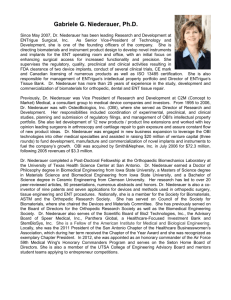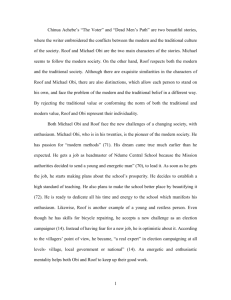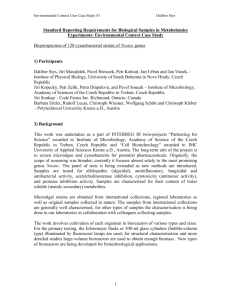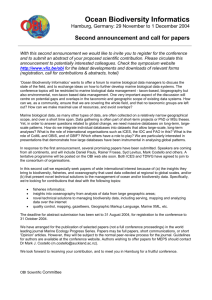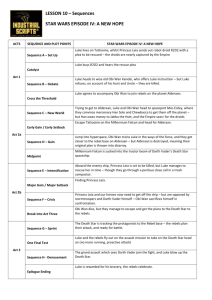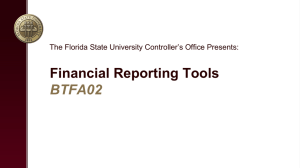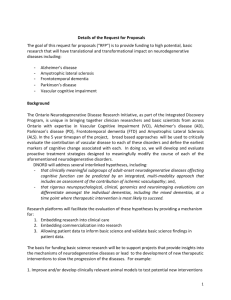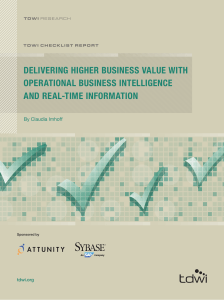Brain-CODE Security Policies
advertisement
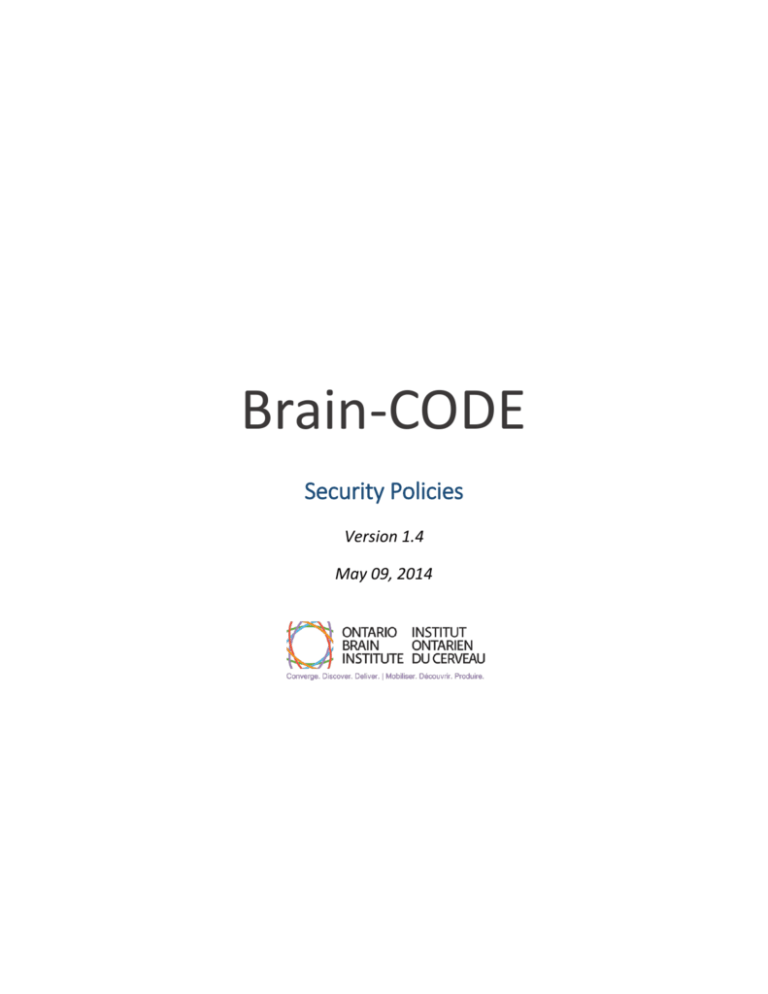
Brain-CODE Security Policies Version 1.4 May 09, 2014 Brain-CODE Information Security Policy May 09, 2014 Introduction Information stored in Brain-CODE is an asset that OBI has a duty and responsibility to protect. The availability of complete and accurate information is essential to Brain-CODE functioning in an efficient manner and to providing services to researchers, collaborators, and business partners. Brain-CODE holds and processes confidential and personal information, including personal health information, on private individuals, employees and partners, and information relating to its own operations. In processing information Brain-CODE has a responsibility to safeguard information and prevent its misuse. The purpose and objective of this Information Security Policy is to set out a framework for the protection of Brain-CODE information assets: to protect Brain-CODE information from all threats, whether internal or external, deliberate or accidental, to enable secure information sharing, to encourage consistent and professional use of information, to ensure that everyone is clear about their roles in using and protecting information, to ensure business continuity and minimize business damage, to protect Brain-CODE from legal liability and the inappropriate use of information. The Information Security Policy is a high level document, and adopts a number of controls to protect information. The controls are delivered by policies, standards, processes, procedures, and supported by training and tools. Brain-CODE Security Policies Version 1.4 – May 09, 2014 1 1. Scope 1.1 This Information Security Policy outlines the framework for management of Information Security within Brain-CODE. 1.2 The Information Security Policy, standards, processes and procedures apply to all staff and employees of OBI, contractual third parties and agents of OBI who have access to the Brain-CODE information systems or information. 1.3 The Information Security Policy applies to all forms of information including but not limited to: speech, spoken face to face, or communicated by phone or radio, hard copy data printed or written on paper, information stored in manual filing systems, communications sent by post / courier, fax, electronic mail, stored and processed via servers, PCs, laptops, mobile phones, PDAs, stored on any type of removable media, CD, DVD, tape, USB memory sticks, digital cameras. 2. Terms and Definitions For the purpose of this document the following terms and definitions apply. Asset: Anything that has value to OBI. Control: Means of managing risk, including policies, procedures, guidelines, practices. Guideline: A description that clarifies what should be done and how. Information Security: Preservation of confidentiality, integrity and availability of information. Policy: Overall intention and direction as formally expressed by management. Risk: Combination of the probability of an event and its consequence. Third Party: Person or body that is recognized as being independent. Threat: Potential cause of an unwanted incident, which may result in harm to a system. Vulnerability: Weakness of an asset that can be exploited by one or more threats. Brain-CODE Security Policies Version 1.4 – May 09, 2014 2 3. Structure of this Policy 3.1 This policy is based upon ISO 27002 and is structured to include the 11 main security category areas within the standard. 3.2 This policy is a high level policy which is supplemented by additional security policy documents which provide detailed policies and guidelines relating to specific security controls. 4. Risks 4.1 Data and information which is collected, analyzed, stored, communicated and reported upon may be subject to theft, misuse, loss and corruption. 4.2 Data and information may be put at risk by poor education and training, misuse, and the breach of security controls. 4.3 Information security incidents can give rise to embarrassment, financial loss, non-compliance with standards and legislation as well as possible judgements being made against OBI. 4.4 OBI will undertake risk assessments to identify, quantify, and prioritize risks. Controls will be selected and implemented to mitigate the risks identified. 4.5 Risk assessments will be undertaken using a systematic approach to identify and estimate the magnitude of the risks. 5. Security Policy 5.1 5.2 Information Security Policy Document 5.1.1 The information security policy document sets out the approach to managing information security. 5.1.2 The information security policy is approved by management and is communicated to all staff and employees of OBI, contractual third parties and agents of the OBI. Review 5.2.1 The security requirements for Brain-CODE will be reviewed at least annually by the Brain-CODE Director of IT and approved by OBI. Formal requests for changes will be raised for incorporation into the Information Security Policy, processes, and procedures. Brain-CODE Security Policies Version 1.4 – May 09, 2014 3 6. 6.1 Organization of Information Security Statement of Management Intent 6.1.1 It is the policy of Brain-CODE to ensure that Information will be protected from a loss of: Confidentiality: so that information is accessible only to authorized individuals. Integrity: safeguarding the accuracy and completeness of information and processing methods. Availability: so that authorized users have access to relevant information when required. 6.1.2 The Director of IT will review and make recommendations on the security policy, policy standards, directives, procedures, incident management and security awareness education. 6.1.3 Regulatory, legislative and contractual requirements will be incorporated into the Information Security Policy, processes and procedures. 6.1.4 The requirements of the Information Security Policy, processes, and procedures will be incorporated into OBI operational procedures and contractual arrangements. 6.1.5 OBI will work towards implementing the ISO 27000 standards, the international standard for Information Security. 6.1.6 Guidance will be provided on what constitutes an Information Security Incident. 6.1.7 All breaches of information security, actual or suspected, must be reported and will be investigated. 6.1.8 Business continuity plans will be produced, maintained and tested. 6.1.9 Information security education and training will be made available to all staff and employees. 6.1.10 Information stored by OBI will be appropriate to the purposes of Brain-CODE, defined as "Purposes" in the OBI Governance Policy, Definitions and Policy Framework. Brain-CODE Security Policies Version 1.4 – May 09, 2014 4 6.2 Information Security Coordination 6.2.1 The security of information will be managed within an approved framework through assigning roles and coordinating implementation of this security policy across OBI and in its dealings with third parties. 6.2.2 Specialist external advice will be drawn upon where necessary so as to maintain the Information Security Policy, processes and procedures to address new and emerging threats and standards. OBI’s auditors will review the adequacy of the controls that are implemented to protect the OBI information and recommend improvements where deficiencies are found. 7. Asset Management 7.1 OBI’s assets will be appropriately protected. 7.2 All assets (data, information, software, computer and communications equipment, service utilities and people) will be accounted for and have an owner. 7.2 Owners will be identified for all assets and will be responsible for the maintenance and protection of their assets. 8. Human Resources Security 8.1 Brain-CODE security policies will be communicated to all employees, contractors and third parties to ensure that they understand their responsibilities. 8.2 Security responsibilities will be included in job descriptions and in terms and conditions of employment. 8.3 Verification checks will be carried out on all new employees, contractors and third parties. 9. Physical and Environment Security 9.1 Critical or sensitive information processing facilities will be housed in secure areas. 9.2 The secure areas will be protected by defined security perimeters with appropriate security barriers and entry controls. 9.3 Critical and sensitive information will be physically protected from unauthorized access, damage and interference. Brain-CODE Security Policies Version 1.4 – May 09, 2014 5 10. Communications and Operations Management 10.1 OBI will operate its information processing facilities securely. 10.1 Responsibilities and procedures for the management, operation and ongoing security and availability of all data and information processing facilities will be established. 10.2 Appropriate operating procedures will be put in place. 10.3 Segregation of duties will be implemented, where appropriate, to reduce the risk of negligent or deliberate system misuse. 11. Access Control 11.1 Access to all information will be controlled. 11.2 Access to information and information systems will be driven by business requirements. Access will be granted or arrangements made for employees, partners, suppliers according to their role, only to a level that will allow them to carry out their duties. 11.3 A formal user registration and deregistration procedure will be implemented for access to all information systems and services. 12. Information Systems Acquisition, Development, Maintenance 12.1 The information security requirements will be defined during the development of business requirements for new information systems or changes to existing information systems. 12.2 Controls to mitigate any risks identified will be implemented where appropriate. 13. Information Security Incident Management 13.1 Information security incidents and vulnerabilities associated with information systems will be communicated in a timely manner. Appropriate corrective action will be taken. 13.2 Formal incident reporting and escalation will be implemented. 13.3 All employees, contractors and third party users will be made aware of the procedures for reporting the different types of security incident, or vulnerability that might have an impact on the security of OBI’s assets. Brain-CODE Security Policies Version 1.4 – May 09, 2014 6 13.4 Information security incidents and vulnerabilities will be reported as quickly as possible to the Brain-CODE Security Committee. 14. Business Continuity Management 14.1 OBI will put in place arrangements to protect critical business processes from the effects of major failures of information systems or disasters and to ensure their timely resumption. 14.2 A business continuity management process will be implemented to minimize the impact on OBI and recover from loss of information assets. Critical business processes will be identified. 14.3 Business impact analysis will be undertaken of the consequences of disasters, security failures, loss of service, and lack of service availability. 15. Compliance 15.1 OBI will abide by any law, statutory, regulatory or contractual obligations affecting its information systems. 15.2 The design, operation, use and management of information systems will comply with all statutory, regulatory and contractual security requirements. 16. Additional Security Policy Documents This policy is supplemented by additional security policy documents which provide detailed policies and guidelines, including: Roles and Responsibilities Physical Security Network Security Information Backups Disaster Recovery Security Breach Access Control Application Development, Testing and Deployment Patch Management Brain-CODE Security Policies Version 1.4 – May 09, 2014 7
